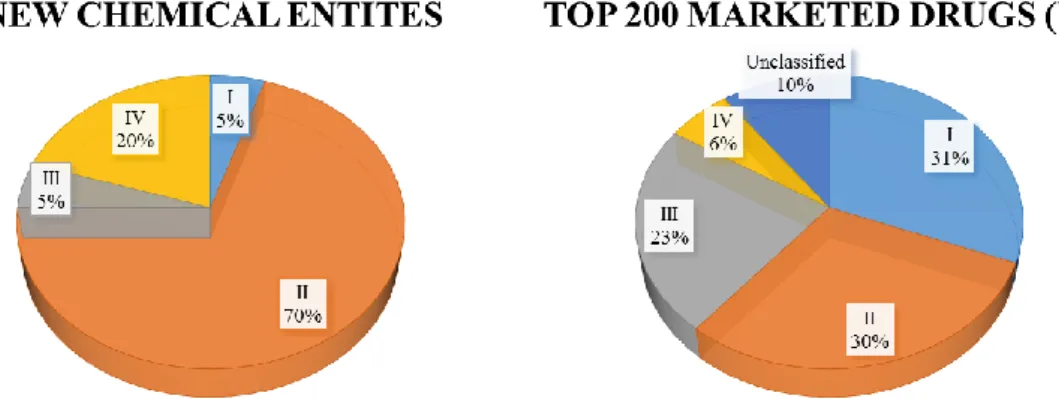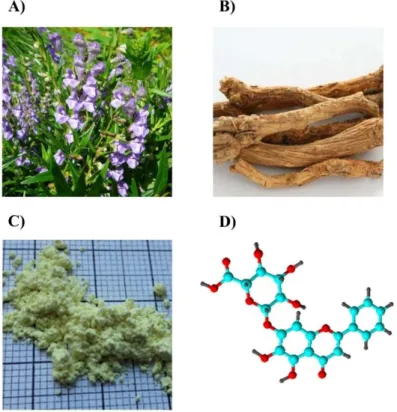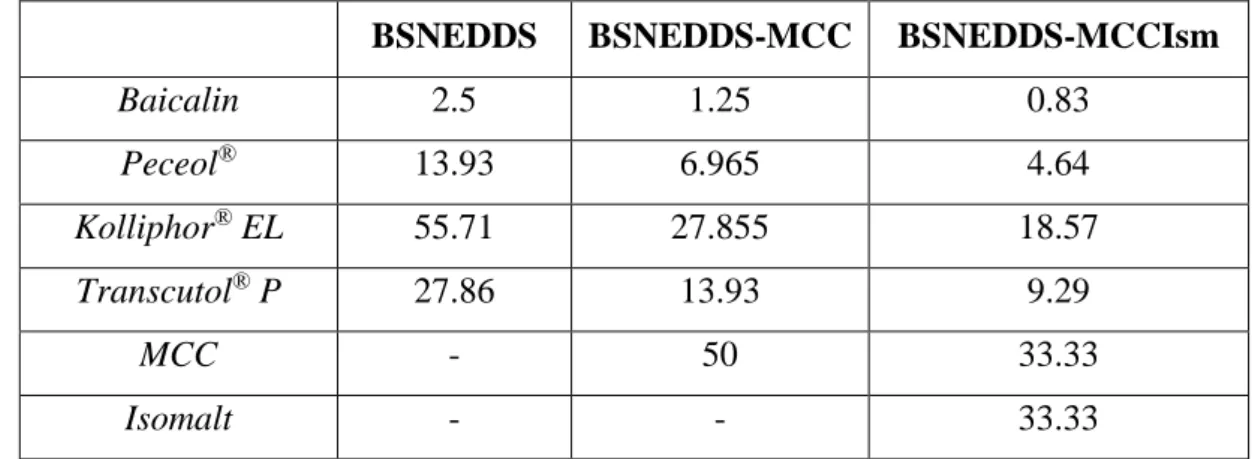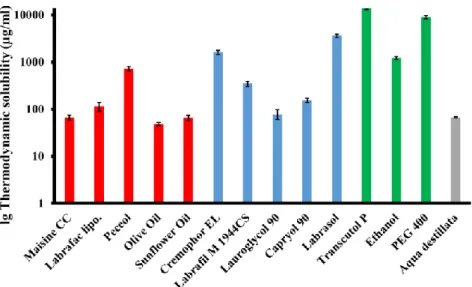Development and Formulation of Baicalin-loaded Drug Delivery Systems
PhD Thesis
Dr. Géza Jakab
Doctoral School of Pharmaceutical Sciences Semmelweis University
Supervisor: István Antal, D.Sc.
Official reviewers:
Angéla Jedlovszky-Hajdú, Ph.D.
Ildikó Bácskay, D.Sc.
Head of the Complex Examination Committee:
Zelkó Romána, D.Sc.
Members of the Complex Examination Committee:
Éva Szökő, D.Sc.
Miklós Vecsernyés, D.Sc.
Budapest, 2020
1
1. Introduction
One of the most tremendous challenges faced by pharmaceutical scientists is poor solubility and/or permeability and the concomitant low bioavailability of new chemical entities (NCE).
Researchers often find promising candidates during drug screening; however, if the molecule exhibits unsuitable physico-chemical properties, the chance of delivering the adequate dose to the site of action is diminished. In the last years a negative tendency has appeared in the drug discovery pipeline: approx. 70% of NCEs demonstrate low solubility and high permeability, therefore belongs to Biopharmaceutical Classification System (BCS) II. Conversely, about only 30% of drugs previously brought to the market resides to BCS II. This challenging shift is also expressed in case of BCS IV (low solubility and low permeability) compounds: there is an increase of 3-4 times in favour of NCEs compared to marketed drugs (Fig.1.). Baicalin -the subject of this PhD Thesis- is a bioactive phytopharmacon and can be classified as Class IV. In the scientific literature numerous approaches came up to improve the low bioavailability of different active pharmaceutical ingredients (APIs). With no claim of being exhaustive I would like to notice some of them: cyclodextrin complexation, solid dispersions, liposomes, lipid-based formulations, self-emulsifying systems. In the following sections a detailed explanation can be found related to lipid-based formulations focused on self-emulsifying systems and cyclodextrin complexes.
Figure 1. Trending in Biopharmaceutical Classification System
(http://www.samedanltd.com/magazine/11/issue/158/article/3039; 01/10/2019)
In the last decade the pharmacological and formulation aspects of phytopharmacons captured the attention of scientist worldwide (Fig.2.). This is largely a result of the higher tendency among the general population to use complementary and alternative medicine and live a health-
2
conscious lifestyle. The motivation behind the topic selection was the renaissance of natural products and the challenging physico-chemical and biological properties of baicalin.
Figure 2. The medical plant of Scutellaria baicalensis (A) and its dried root (B). Extracted and purified powder of baicalin (C). 3D structure of baicalin (D).
(https://en.wikipedia.org/wiki/Scutellaria_baicalensis; 01/10/2019) C and D are self-made
2. Objectives
The main objective of this work was to formulate and develop baicalin-loaded DDS in order to counterbalance the negative physicochemical and pharmaceutical properties of baicalin. For this challenging task, the preformulation studies of the drug were put in the focus, which provided strong basis for the development, optimization and comparison of baicalin- cyclodextrin inclusion complexes and of baicalin-loaded self-emulsifying DDS. Considering the above mentioned, my aims were the followings:
1. Quantify the most important biorelevant physicochemical properties of baicalin in terms of acid/base, lipophilicity and thermodynamic solubility in different compendial and physiological media. Explore its polymorphism and crystal structure, crystal habit, particle size, thermal behaviour.
3
2. Preparation and comparative evaluation of various baicalin-CD inclusion complexes. In order to reveal the molecular interactions inside the cavity and to characterize the 3D geometry of the complex, each species was subjected to phase solubility, 1H NMR and 2D ROESY experiments along with molecular modelling of the binding pattern into cyclodextrins. Comparison of computational study and experimental results were also in my interest.
3. Enhance the poor aqueous solubility and dissolution rate via a liquid self- nanoemulsifying drug delivery system. Find an optimized carrier system for baicalin, and to analyse and characterize the reconstituted nanoemulsion using AFM, droplet size, and Zeta-potential measurements, long-term stability tests, and in vitro dissolution studies. Elaborate a sample preparation method for AFM imaging of nanosized droplets was also a substantial goal.
4. Transform liquid self-emulsifying preconcentrates to solid carriers and prepare self- nanoemulsifying matrix pellets by extrusion-spheronization method. Identify the critical process parameters and reveal the relationships. Analyse the physical state of baicalin in the solid dosage form and follow the incidental alteration(s) in time. Examine the drug release and the reconstitutability of droplets by in vitro dissolution studies at pH 1.2 and pH 6.8.
3. Methods
Thermodynamic solubility
The thermodynamic solubility of baicalin in various media was determined by saturation shake- flask method. Pure baicalin was added to 5 ml of each solvent in sealed vials and all samples were stirred and thermostated. After this period, 24 h of sedimentation cycle was adopted without stirring. Aliquots were taken and were suitably diluted with blank buffers. The absorbance was measured at λ = 316 nm by UV-VIS spectroscopy.
Acid-base properties
NMR-pH titrations were performed to determine the acid-base properties of baicalin. Titrations were carried out in solutions containing 95% (v/v) H2O and 5% (v/v) D2O, with the addition of small amounts of 0.1 M HCl and NaOH. The ionic strength was kept at 0.15 M by the presence of NaCl. The concentration of baicalin and its methyl ester was 1.0 × 10−3 M and ascorbic acid was used in large excess (5.0 × 10−3 M) to prevent the oxidation of the studied catechol
4
molecules in alkaline solutions. The sample volume was 600 μl. NMR spectra were referenced to the internal standard DSS (sodium 3- (trimethylsilyl)-1-propanesulfonate).
Distribution coefficients measurement
The distribution coefficients were calculated from the absorbance of the molecules before and after partitioning at several octanol/water phase ratios. For the pH control, a pH 7.40 phosphate buffer and a standardized HCl solution were used, with an ionic strength of 0.15 M in both cases. The concentration change of baicalin was followed by UV-absorbance measurements.
Several water/octanol phase ratios were used, depending on the pH and the expected log D value, to ensure that the absorbance of baicalin after partitioning should become approximately half as much as the original value before partitioning. Then, the two phases were intensively stirred for 2 h. After separation of the equilibrated phases and centrifugation, the concentration of baicalin was determined by UV spectrophotometry.
Baicalin-cyclodextrin inclusion complexation
The phase solubility studies were carried out according to the method of Higuchi-Connors.
Experimentally, an excess amount of baicalin was added to increasing concentrations of various distilled water-based CD stock solutions at pH 4.5. The vials were agitated by ultrasonication followed by 72 h of sedimentation. After sedimentation, the saturated supernatant was taken and centrifuged. The drug concentration was obtained via UV spectroscopy.
Component selection and optimization for Self-nanoemulsifying Drug Delivery System The components from 16 candidates were selected based on solubility and emulsifying ability studies. The thermodynamic solubility of baicalin was determined in distilled water, different oils, emulgents, and co-emulgents by saturation shake-flask method detailed above. The determination of emulsifying ability was fulfilled by droplet size and turbidity measurements.
For the optimization of desired formula response surface methodology based on Face Centered Central Composite Design was utilized. Oil:suface active agent ratio (Oil:Smix) and emulgent:co-emulgent ratio were analysed as formulation variables, whereas droplet size (Y1), transmittance (Y2), Zeta-potential (Y3), and PDI (Y4) were selected as responses.
Atomic force microscopy
As a new sample preparation method, BSNEDDS preconcentrate was diluted 107 -fold with distilled water. Five µL of this emulsion was dropped on a freshly cleaved mica surface and was frozen by pouring approximately 30 mL liquid N2 onto it. The sample was immediately
5
placed in the lyophilisation chamber and freeze dried at a standard programme developed in the Departement. Lyophilized samples were imaged in non-contact mode with a Cypher S instrument (at 1–2 Hz) line-scanning rate in air using a silicon cantilever and oscillated at its resonance frequency (typically 300–320 kHz). Images were analyzed by using the built-in algorithms of the AFM driving software.
Preparation of Self-Nanoemulsifying Formulations without (SNEDDS) and with Baicalin (BSNEDDS)
In all cases, oil, emulgent, and co-emulgent were thermostated at 37 ± 1 ◦C and stirred (approximately 500 rpm) in different w/w ratios by a heatable magnetic stirrer. After a 1-h homogenization cycle, they were stored at room temperature in sealed vials until further use.
BSNEDDS were prepared by the above-mentioned method, but at the end of the homogenization cycle, baicalin was added to the optimized pre-concentrate (C = 2.5 mg/mL).
Preparation of self-nanoemulsifying matrix pellets (SNEMPs)
SNEMPs were prepared by extrusion-spheronization method using MCC alone (BSNEDDS- MCC) or with the combination of isomalt (BSNEDDS-MCCIsm). Two different formulas were created according to Table I.
Table I. Composition of liquid BSNEDDS preconcentrate and two SNEMPs expressed in % (w/w)
BSNEDDS BSNEDDS-MCC BSNEDDS-MCCIsm
Baicalin 2.5 1.25 0.83
Peceol® 13.93 6.965 4.64
Kolliphor® EL 55.71 27.855 18.57
Transcutol® P 27.86 13.93 9.29
MCC - 50 33.33
Isomalt - - 33.33
The batch size was 50 g in all cases. The powders were accurately weighed and blended in a mortar with a porcelain pestle for 10 minutes. BSNEDDS was added slowly to the powder with thorough mixing of the components until the liquid preconcentrate was completely adsorbed.
The wet mass was extruded using a single-screw extruder with the rotation speed of 60 rpm.
6
The extrudates were then spheronized for 4 minutes at 1000 rpm in a 105-mm radial plate spheronizer using a saw-toothed frictional plate.
Reconstitution properties of SNEMPs and in vitro dissolution study
Dissolution testing was performed by paddles method with 50 rpm at 37 ± 0.2 °C. The formulations were screened in 500 ml aqueous-based dissolution media at pH=1.2 (Ph.Eur.9) and pH=6.8 (Ph.Eur.9). Pure baicalin, liquid BSNEDDS, BSNEDD-MCC and BSNEDDS- MCCIsm pellets were exposed to the media and at predetermined time-points, 5 ml of samples were withdrawn. After every sampling, media replacement was accomplished with 5 ml of fresh buffer solution. The cumulative drug release was analysed by UV-Vis spectrophotometry at 279 nm against equivalent proportions of excipients as blank. Withdrawn and filtered samples at 120 minutes were characterized for droplet size.
4. Results
Thermodynamic solubility
Baicalin has remarkable pH-dependent solubility (Tbl. II.). The water solubility of baicalin in distilled water was (67.03 ± 1.60 µg/ml). In the highly acidic environment of stomach, the neutral form of baicalin is overwhelmingly dominant, so the measured solubility can be considered as the intrinsic solubility of baicalin (11.64 ± 0.44 µg/ml) at pH 1.2. As the pH increases, the ionization processes contribute significant solubility improvement (10504 ± 330 µg/ml) at pH 6.8 SIF. Significant solubilizing impact of FaSSGF (fasted-state gastric fluid) (33.21 ± 0.72 µg/ml) was found to be correlated to compendial pH 1.2 SGF. The ~3-times increase in solubility can be explained by the presence of surface active agents (lecithin, taurocholate) in FaSSGF.
Table II. Thermodynamic solubility (µg/ml) of baicalin in various compendial and biorelevant media
Medium AVG SD
Aqua dest. 67.03 1.60
pH=1.2 (SGF) 11.64 0.44
pH=6.8 (SIF) 10504 330
pH=1.6 (FaSSGF) 33.21 0.72
pH=6.5 (FaSSIF) 8111 472
7
Acid-base properties and distribution coefficient measurement
Baicalin is a weak triprotic acid (pKa1: 4.21, pKa2: 8.56, pKa3: >14) with one carboxyl and two phenolic hydroxyl groups. The knowledge of pKa values allows the calculation of species distribution diagram of baicalin (Fig.3A).
The neutral form of baicalin (H3B) is dominant up to pH 4.21. The monoanionic form (H2B-) reaches its maximum at the pH of blood (pH 7.40), with 93.5%. The dianionic form (HB2-) becomes the dominant one above pH 8.56, while the trianionic form (B3-) starts to appear only in extremely alkaline solutions that have little relevance to biochemical or physiological processes.
Figure 3. The species distribution diagram (A), and the lipophilicity profile of baicalin (B)
The log P value of the neutral form of baicalin was 1.28 (0.08). In such acidic solutions it is the dominant species and exhibits obviously higher lipophilicity than the anionic forms. The contribution of the neutral form is dominant up to pH 6.77, but at higher pH values the anionic form is the more important one for the distribution coefficient (Fig.3B).
Baicalin-cyclodextrin inclusion complexation
The phase solubility profile of baicalin- α-cyclodextrin complex showed a typical BS-type solubility curve, where the initial ascending portion is followed by a plateau region and then a slight decrease in total baicalin solubility accompanied by precipitation of complex. Baicalin- β-, γ-, HP-β-, RAMEB-, SBE-β-CD complexes revealed a linear enhancement in solubility of
8
baicalin upon addition of increasing amounts of CD (Fig. 4.). 5.47 times solubility enhancement was demonstrated by γ-CD encapsulation (67.03 μg/mL vs. 366.64 μg/mL) compared to solubility of baicalin in distilled water. In case of RAMEB, SBE-β-CD and HP-β-CD the solubility improvement was significant, but less expressed, 2.88-, 2.55-, and 1.59 times, respectively. The inclusion complex of α-, and β-CD didn’t reveal significant solubility enhancement.
Figure 4. Phase solubility profiles of baicalin and various CDs
Component selection and optimization for Self-nanoemulsifying Drug Delivery System Amongst the various oils that were examined, Peceol® showed significantly the highest solubilizing capacity (719.1 ± 83.05 µg/ml) for baicalin followed by Labrafac™ Lipophile WL 1349 and Maisine® CC (Fig.5.). Transcutol® P, an ether derivate revealed extreme high (13742.5 ± 691.74 µg/ml) solubilizing capacity, and were chosen therefore as co-surfactant for further investigations. The highest solubility of baicalin was obtained in Labrasol® (3609.4 ± 277.39 µg/ml) followed by Kolliphor® EL and Labrafil® M 1944 CS. Solubility studies are necessary, but not sufficient conditions for selecting an emulgent, so Kolliphor® EL, Labrafil® M 1944 CS and Labrasol® were tested further for emulsification ability (Fig.6.).
9
Figure 5. Thermodynamic solubility of baicalin in various oils (red), emulgents (blue), co- emulgents (green) and distilled water (gray). (Mean ± SD; n=3)
Figure 6. Emulsification ability of Kolliphor® EL (blue), Labrafil® M 1944 CS (red) and Labrasol® (yellow) with Peceol® at different w/w ratios characterized by droplet size (A) and
transmittance (B) analysis. (Mean ± SD; n=3)
All Labrasol® containing formulations proved unacceptable self-emulsification efficiency and turbid systems were generated. Kolliphor® EL showed the best emulsification ability and produced the most desired droplets with 151 ± 1.2871 nm. Turbidity analysis revealed a clear augmentation of transmittance with increased oil:emulgent ratios for Kolliphor® EL and Labrasol®, however Labrafil® M 1944 CS expressed a sharp decline. Kolliphor® EL gave the greatest transmittance and lowest droplet size with increased oil:emulgent ratios. According to the graphical optimization, the best composition was Peceol® (14.29%, w/w), Kolliphor® EL (57.14%, w/w), and Transcutol® P (28.57%, w/w).
10 Atomic force microscopy
Lyophilized nanodroplets dispersed homogeneously on mica surface showing no signs of aggregation (Fig.7A). They appeared as circular objects with smooth surface and rounded topography (Fig.7B), which corresponds well to what one would expect from a surface adsorbed droplet. Height of particles followed a slightly right skewed distribution (Fig.7C).
Figure 7. AFM amplitude-contrast images of surface absorbed lyophilized oil droplets (A).
Area marked by dashed line is shown in (B). (C) Height distribution of droplets (n=122).
Reconstitution properties of SNEMPs and in vitro dissolution study
The reconstitution was successful because of the low PDI values in both dissolution media for each formulations indicating narrow droplet size distribution. It was also observed that the mean droplet size increased with the solidification of BSNEDDS but it was far below 200 nm (Tbl. III).
Table III. Z-avg and PDI values of different liquid and solid formulations at pH=1.2 and pH=6.8 measured during reconstitution analysis (Mean ± SD, n=3)
Z-avg (nm)
SNEDDS BSNEDDS BSNEDDS-MCCIsm BSNEDDS-MCC pH=1.2 50.41 ± 0.321 84.93 ± 0.323 132.1 ± 0.152 131.1 ± 0.264 pH=6.8 52.84 ± 0.632 86.67 ± 0.295 132.9 ± 0.208 139.3 ± 0.472
PDI
pH=1.2 0.231 ± 0.01 0.321 ± 0.002 0.396 ± 0.005 0.383 ± 0.002 pH=6.8 0.217 ± 0.01 0.347 ± 0.003 0.411 ± 0.007 0.331 ± 0.01 In vitro release profiles at pH 1.2 are shown in Figure 8. Baicalin instantaneously released from BSNEDDS. Pure drug showed slower dissolution (5.77 ± 3.77%) for the initial period of 5 minutes. After the disintegration period of solid formulations, whole amount of baicalin was
11
dissolved in case of BSNEDDS-MCCIsm and BSNEDDS-MCC within 10 minutes. Figure 9.
represents dissolution profiles at pH 6.8. BSNEDDS dissolved total amount of its drug content within 5 minutes. Self-nanoemulsifying formulations significantly improved the dissolution and dissolution rate of drug comparing to pure form of API. The optimized solid BSNEDDS- MCCIsm released 100% of incorporated baicalin within 10 minutes irrespective to pH value of dissolution media.
Figure 8. In vitro dissolution profile of baicalin powder, BSNEDDS, BSNEDDS-MCC and BSNEDD-MCCIsm at pH 1.2
Figure 9. In vitro dissolution profile of baicalin powder, BSNEDDS, BSNEDD-MCC and BSNEDDS-MCCIsm at pH 6.8
0 20 40 60 80 100
0 20 40 60 80 100 120
Dissolved drug content (%)
Sampling time (min)
Baicalin powder BSNEDDS
BSNEDDS- MCC BSNEDDS- MCCGAL
0 20 40 60 80 100
0 20 40 60 80 100 120
Dissolved drug content (%)
Sampling time (min)
Baicalin powder BSNEDDS
BSNEDDS- MCC BSNEDDS- MCCGAL
BSNEDDS- MCCIsm
BSNEDDS- MCCIsm
12
5. Conclusions
The main objective of this work was to formulate and develop baicalin-loaded DDS in order to counterbalance the negative physicochemical and pharmaceutical properties of baicalin. All of the proposed goals were achieved in this study and many further relationships were identified and analysed. In the introduction as well as in the experimental section several challenges and questions were highlighted, which are fundamental, in my view, for the quality control and successful formulation of cyclodextrin and nanoemulsion-based DDS. Based on the results, the following conclusion can be drawn:
1. Baicalin has promising pharmacological effects, but it demonstrates low water solubility and low lipophilicity, which hampers its oral bioavailability (BCS IV). Significant, pH- dependent solubility was found, which can be explained by the fact that the molecule has three acidic functional groups (pKa1: 4.21, pKa2: 8.56, pKa3: >14). The neutral (transportable) form is dominant up to pH 4.2, but in acidic environment its solubility is so low, that the oral delivery of baicalin might be problematic. However, in case of biorelevant conditions (FaSSGF), the presence of neutral emulsifying agents and fatty acids had a significant positive impact on the solubility of baicalin; this beneficial drug-food interaction could be exhausted in liberation and absorption processes (drug intake with/after meal). The molecule decomposes above 50 °C and in alkaline solutions, which are restrictive factors considering further processability.
2. Six different CD derivates were examined to study the solubility enhancement of baicalin along with stability and geometry of inclusion complexes. Molecular modelling analysis pointed out different binding patterns and complexation energy for each baicalin-CD complex. In accordance with the previous hypothesis, thermodynamically the most favourable complex proved to be baicalin-γ-CD host-guest complex (ΔE = − 181.5 kJ mol−1), which fact was confirmed by phase-solubility (≈ 5.5 times solubility enhancement) and NMR spectroscopic measurements. The preliminary studies showed that it makes sense to continue the CD project with more detailed and deeper in vitro and in vivo investigations.
3. Dissolution kinetics of baicalin was improved in a self-nanoemulsifying system taking different types of oils, surfactants, co-surfactants, and ideal ratio of components into consideration, based on response surface methodology, using a central composite experimental design. The best composition contains Peceol® (14.29%, w/w), Kolliphor®
13
EL (57.14%, w/w), and Transcutol® P (28.57%, w/w). Droplet size was measured by DLS method and verified by AFM, together with morphological characterization. A new sample preparation method gave the opportunity to analyse the freeze-dried samples without any signs of aggregation of droplets. Droplet size after dispergation of BSNEDDS pre-concentrate was highly desirable, with 86.75 ± 0.3553 nm; the Zeta- potential was -24.3 ± 1.44 mV, which is also acceptable. The results proved that the low aqueous solubility and dissolution rate of baicalin can be significantly improved by the optimized BSNEDDS formula. The pre-concentrate showed very rapid emulsification (within seconds) and nanosized droplets were generated.
4. Transformation of liquid BSNEDDS preconcentrate to different solid carriers and the preparation of self-nanoemulsifying matrix pellets were carried out by extrusion- spheronization method. The selection of MCC and isomalt as carriers was an ideal choice as both of the pellet formulas prepared using them demonstrated sufficient physical characteristics. BSNEDDS-MCC and BSNEDDS-MCCIsm had spherical shape, narrow particle size distribution, excellent flow, low friability. The only difference was the slightly accelerated disintegration time in case of BSNEDDS- MCCIsm because of the hydrophilic nature of isomalt. FT-IR, Raman vibrational spectroscopic characterization techniques demonstrated the amorphous physical state of baicalin in solid formulations, which is partially responsible for the enhanced dissolution behaviour. In-vitro dissolution studies showed significant, pH-independent dissolution rate and saturation solubility improvement (100%, within 15 minutes). On reconstitution investigations it was pointed out that baicalin is released from the solid dosage form in colloidal dispersion that had an average size of 130-140 nm. These results indicate the significance of solid self-nanoemulsifying systems, which are suitable for the oral delivery of pharmacons possessing low solubility and dissolution rate.
14
6. Publications
Publications pertaining to the doctoral thesis
I. Géza Jakab, Dóra Bogdán, Károly Mazák, Ruth Deme, Zoltán Mucsi, István M.
Mándity, Béla Noszál, Nikolett Kállai-Szabó, István Antal. Physicochemical profiling of baicalin along with the development and characterization of cyclodextrin inclusion complexes. AAPS PharmSciTech, 2019;20(8) doi:10.1208/s12249-019-1525-6
II. Géza Jakab, Viktor Fülöp, Tamás Bozó, Emese Balogh, Miklós Kellermayer, István Antal. Optimization of quality attributes and atomic force microscopy imaging of reconstituted nanodroplets in baicalin loaded Self-nanoemulsifying formulations.
Pharmaceutics 2018;10, (275):1-17. doi:10.3390/pharmaceutics10040275
III. Jakab Géza, Fülöp Viktor, Sántha Konrád, Szerőczei Debóra, Balogh Emese, Antal István. Önemulgeáló hatóanyag-felszabadító rendszerek, mikroemulziók és nanoemulziók formulálási lehetőségei Acta Pharmaceutica Hungarica 2017;87(1):27- 34.
Publications pertaining to different subjects
I. László Forgách, Nikolett Hegedűs, Ildikó Horváth, Bálint Kiss, Noémi Kovács, Zoltán Varga, Géza Jakab, Tibor Kovács, Parasuraman Padmanabhan, Krisztián Szigeti, Domokos Máthé Fluorescent, Prussian Blue-Based Biocompatible Nanoparticle System for Multimodal Imaging Contrast, Nanomaterials, 2020; 10(9) 1732
doi: 10.3390/nano10091732
II. Viktor Fülöp, Géza Jakab, Bence Tóth, Emese Balogh, István Antal. Study on optimization of wet milling process for the development of albendazole containing nanosuspension with improved dissolution. Periodica Polytechnica Chemical Engineering (accepted)
III. Viktor Fülöp, Géza Jakab, Tamás Bozó, Bence Tóth, Dániel Endrésik, Emese Balogh, Miklós Kellermayer, István Antal. Study on the dissolution improvement of albendazole using reconstitutable dry nanosuspension formulation, European Journal of Pharmaceutical Sciences 2018;123:70–78. doi:10.1016/j.ejps.2018.07.027
IV. Fülöp Viktor, Balogh Emese, Jakab Géza, Antal István. A nanogyógyszerek és nanotechnológia formulálási vonatkozásai I. Bevezetés, biofarmáciai szempontok Acta Pharmaceutica Hungarica 2016;86(2):43-52.







